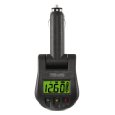I worked out this wiring diagram for the Woodsman. There will be an on board battery charger/tender so that when I am plugged into shore power the battery will be charged and maintained. In the past I have some experience with deep cycle batteries from trying to maintain batteries for an electric trolling motor. You don't want to let them set over the winter without being connected to a tender. The tender (or minder) will monitor the voltage on the battery and add charge as needed which preserves the life of the battery and allows you to get maximum charge cycles and performance for the full life of the battery. Other than that the wiring will be pretty basic. There will be a master switch and old school 20A fuse to protect the 120V system as well as a GFCI breaker on one of the outlets for safety. Then a 40A breaker and master switch on the 12V circuit with a fuse box that has positions for 8 automotive fuses and a grounding bus. The battery will be in a box on the tongue of the trailer and the other components will be housed in a cabinet near the front of the trailer. I will show these in subsequent posts.
I checked into the meters I would need to install to have a constant read out of voltage and current. Although it would be nice to have these, I decided not to permanently install digital meters. I am using LEDs and florescent lighting to keep the current draw as low as possible. Mainly I would like an easy way to check the voltage to make sure I don't drain the battery too far which would affect its lifetime. I can do this with one of the devices shown below, they cost around $15. You just plug it into one of your 12V outlets to check the voltage at any time.






